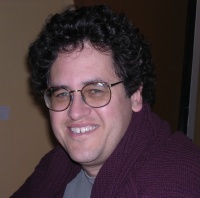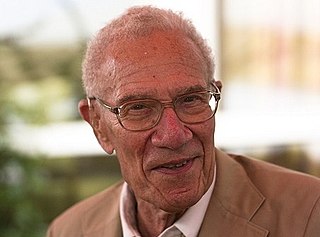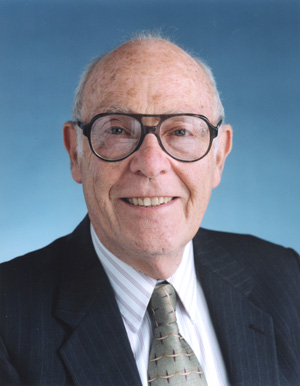
Claude Elwood Shannon was an American mathematician, electrical engineer, computer scientist and cryptographer known as the "father of information theory".
Computability theory, also known as recursion theory, is a branch of mathematical logic, computer science, and the theory of computation that originated in the 1930s with the study of computable functions and Turing degrees. The field has since expanded to include the study of generalized computability and definability. In these areas, computability theory overlaps with proof theory and effective descriptive set theory.

John Carlos Baez is an American mathematical physicist and a professor of mathematics at the University of California, Riverside (UCR) in Riverside, California. He has worked on spin foams in loop quantum gravity, applications of higher categories to physics, and applied category theory. Additionally, Baez is known on the World Wide Web as the author of the crackpot index.

Robert Merton Solow, GCIH is an American economist whose work on the theory of economic growth culminated in the exogenous growth model named after him. He is currently Emeritus Institute Professor of Economics at the Massachusetts Institute of Technology, where he has been a professor since 1949. He was awarded the John Bates Clark Medal in 1961, the Nobel Memorial Prize in Economic Sciences in 1987, and the Presidential Medal of Freedom in 2014. Four of his PhD students, George Akerlof, Joseph Stiglitz, Peter Diamond and William Nordhaus later received Nobel Memorial Prizes in Economic Sciences in their own right.

Robert Gray Gallager is an American electrical engineer known for his work on information theory and communications networks.

Elwyn Ralph Berlekamp was a professor of mathematics and computer science at the University of California, Berkeley. Berlekamp was widely known for his work in computer science, coding theory and combinatorial game theory.

Michael Artin is a German-American mathematician and a professor emeritus in the Massachusetts Institute of Technology Mathematics Department, known for his contributions to algebraic geometry.

Robert Irving Soare is an American mathematician. He is the Paul Snowden Russell Distinguished Service Professor of Mathematics and Computer Science at the University of Chicago, where he has been on the faculty since 1967. He proved, together with Carl Jockusch, the low basis theorem, and has done other work in mathematical logic, primarily in the area of computability theory.
Gerald Enoch Sacks was a logician whose most important contributions were in recursion theory. Named after him is Sacks forcing, a forcing notion based on perfect sets and the Sacks Density Theorem, which asserts that the partial order of the recursively enumerable Turing degrees is dense. Sacks had a joint appointment as a professor at the Massachusetts Institute of Technology and at Harvard University starting in 1972 and became emeritus at M.I.T. in 2006 and at Harvard in 2012.

John Werner Cahn was an American scientist and recipient of the 1998 National Medal of Science. Born in Cologne, Weimar Germany, he was a professor in the department of metallurgy at the Massachusetts Institute of Technology (MIT) from 1964 to 1978. From 1977, he held a position at the National Institute of Standards and Technology. Cahn had a profound influence on the course of materials research during his career. One of the foremost authorities on thermodynamics, Cahn applied the basic laws of thermodynamics to describe and predict a wide range of physical phenomena.
Ernst Adolph Guillemin was an American electrical engineer and computer scientist at the Massachusetts Institute of Technology who spent his career extending the art and science of linear network analysis and synthesis. His nephew Victor Guillemin is a math professor at MIT, his nephew Robert Charles Guillemin was a sidewalk artist, his great-niece Karen Guillemin is a biology professor at the University of Oregon, and his granddaughter Mary Elizabeth Meyerand is a Medical Physics Professor at the University of Wisconsin-Madison.
The low basis theorem is one of several basis theorems in computability theory, each of which showing that, given an infinite subtree of the binary tree , it is possible to find an infinite path through the tree with particular computability properties. The low basis theorem, in particular, shows that there must be a path which is low; that is, the Turing jump of the path is Turing equivalent to the halting problem .
David Alexander Vogan, Jr. is a mathematician at the Massachusetts Institute of Technology who works on unitary representations of simple Lie groups.
Steven Alan Orszag was an American mathematician.
In the mathematical field of computability theory, a PA degree is a Turing degree that computes a complete extension of Peano arithmetic (Jockusch 1987). These degrees are closely related to fixed-point-free (DNR) functions, and have been thoroughly investigated in recursion theory.
In computability theory, a Π01 class is a subset of 2ω of a certain form. These classes are of interest as technical tools within recursion theory and effective descriptive set theory. They are also used in the application of recursion theory to other branches of mathematics.

Jacob Alexander Lurie is an American mathematician who is a professor at the Institute for Advanced Study. Lurie is a 2014 MacArthur Fellow.

Paul Seidel is a Swiss-Italian mathematician. He is a faculty member at the Massachusetts Institute of Technology.

Douglas Conner Ravenel is an American mathematician known for work in algebraic topology.

Louise Hay was a French-born American mathematician. Her work focused on recursively enumerable sets and computational complexity theory, which was influential with both Soviet and US mathematicians in the 1970s. When she was appointed head of the mathematics department at the University of Illinois at Chicago, she was the only woman to head a math department at a major research university in her era.












